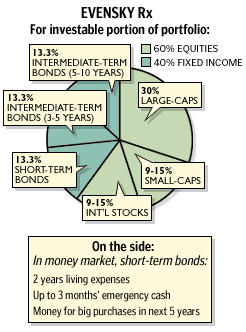
NEW YORK (CNN/Money) -
If you've just retired or are five minutes from doing so, you may be sweating the possibility that your golden years couldn't have come at a worse time.
The problem with retiring into a bear market is that it erodes some of the principal you were counting on to compound and sustain your nest egg while you enjoy a job-free life. Therefore, it challenges your assumptions about what you can afford to withdraw every year.
Say you expected to have a $1.5 million portfolio the day you retired and planned to withdraw 5 percent a year to live on. That's $75,000. But the bear market eats a third of your nest egg, leaving you with only $1 million. Now your 5 percent is worth only $50,000. If you insist on taking the $75,000 all the same, which is 7.5 percent of your nest egg, you significantly increase your chance of running out of money -- unless you can boost the returns on your portfolio or you die long before expected.
If you want to play it safe
To determine whether you need to adjust your income expectations, try the following rule of thumb from certified financial planner William Bengen of San Diego. Multiply your desired pre-tax retirement income by 25 to figure out how large your nest egg should be to fund your desires while minimizing the risk of outliving your savings.
So if, for example, you want to withdraw $50,000 a year from your portfolio, in addition to your Social Security benefits and pension money, Bengen believes you should have a $1.25 million nest egg at the beginning of retirement.
That assumes a 4 percent annual withdrawal rate. Based on his research of actual stock returns and retirement scenarios over the past 75 years, Bengen found that retirees who draw down no more than 4 percent of their portfolios every year stand a great chance their money will outlive them. Retirees who draw down 5 percent a year run a 30 percent chance their nest egg will run out of steam before they do; and those who pull down 6 percent to 7 percent "are taking a tremendous risk," Bengen said, noting they face a greater than 50 percent chance of running out of money before they die.
His research takes into account worst-case scenarios of the past such as prolonged bear markets, periods of high inflation and down markets in the early years of one's retirement. And it's based on a portfolio that has between 50 percent and 75 percent in stocks. Ideally, for those with a moderate risk tolerance who are just retiring, Bengen recommends having 65 percent of your nest egg in S&P 500 stocks, 27 percent in intermediate-term bonds maturing in three to 10 years, and 8 percent -- that is, two years of living expenses -- in the money market.
Bengen's 4-percent-withdrawal rate enables retirees to give themselves inflation-adjusted raises each year. For example, say you have a $1 million portfolio and you take out $40,000 the first year (4 percent). If inflation is running at 3 percent, the next year you take out $41,200. (Three percent of $40,000 is $1,200.)
Squeezing out a little more
If 4 percent a year seems too low for your needs, you may be able to withdraw slightly more and still stand a reasonably good chance you'll call it a day before your portfolio does, although you may end up leaving less money to your heirs.
To support a higher withdrawal rate, certified financial planner Harold Evensky of Coral Gables, Fla., recommends using a "baseline conservative portfolio." Namely, a 60-40 split between stocks and bonds for the investable portion of your nest egg. Such a portfolio, if invested well, has the potential to yield a 7.8 percent annual return, which, assuming a 3 percent inflation rate, would allow for annual pre-tax withdrawals up to 4.8 percent, he said.
Thirty percent of your investable money would be in large-cap stocks; between 9 percent and 15 percent in small caps, and up to 15 percent in international stocks. Evensky recommends investing in index funds or exchange-traded funds for the most part, since they offer low expenses, broad exposure and tax-efficiency.
The rest of your investments would be spread among bonds -- with a third in intermediate term bonds that mature in three to five years; a third in similar bonds that mature in five to 10 years; and a third in short-term bonds. For tax-deferred accounts such as your IRA, he recommends investing in Treasury Inflation-Protected Securities (TIPS) or in funds that invest in TIPS.
In addition, Evensky suggests keeping cash on the side. "That way, you're not forced to withdraw when the market's down," he said. He tells clients to use a money market and short-term bond fund to house two years of living expenses, up to three months of emergency cash and any money needed for big purchases in the next five years.
So, for example, if you have a $1 million portfolio, you might keep $110,000 in cash and short-term bonds.
Strategies for making withdrawals
No matter what withdrawal rate you choose, you still want to be smart about how you tap your accounts. Otherwise, your nest egg could shrink faster than you'd like.
The first thing to do is assess what kind of income your investments will throw off annually, regardless of market performance. With dividends from your stocks and interest from your bonds, "there should be natural cash generation that's occurring," said certified financial planner David Foster of Cincinnati.

Those dividends and interest should be deposited automatically in your cash reserve fund, said certified financial planner Barry Picker of Brooklyn, N.Y.
Say your stocks throw off $25,000 in dividends and interest annually. If you need an income of $40,000 -- you must come up with the remaining $15,000. Deciding what to tap is a two-part decision.
First, make sure you're cashing out your investments tax-efficiently. As a general rule, experts recommend tapping taxable accounts first and leaving tax-deferred accounts such as your IRA untouched as long as possible. The IRA can grow faster without the drag of taxes and more often than not you will pay more on IRA withdrawals, since they're taxed as ordinary income, than you will paying the 20 percent long-term capital gains rate on your taxable investments.
There are instances, however, when it may make sense to tap your IRA before age 70-1/2, when you're required to take minimum distributions annually, Foster said. Generally speaking, if your tax bracket is less than what it will be in your 70s, you'll pay less on those withdrawals now than if you wait until you're 70-1/2. But you have to do the math, especially if making an IRA withdrawal will make more of your Social Security benefits subject to federal tax.
Next, you have to assess market conditions in choosing what to sell. If stocks are doing poorly, chances are your asset allocation is out of whack. So you might sell some bonds to rebalance, Picker said. If stocks are doing well, you might sell some of those. Deciding which stocks go has less to do with whether they're trading at a gain or a loss from your purchase price than whether you think they'll perform well going forward and if you would buy them at their current value, he added. If so, you may want to hold on to them.
Alternatively, if the market is in a prolonged downturn and you like your investments, you might just tap those two years of living expenses you set aside.
No retiree is an island (or a clone)
No matter the market's mood, entering retirement involves making some of the biggest financial decisions of your life. Figuring out what's right for you involves a lot of nuance that no investment article can cover.
Even if you're averse to paying a financial adviser to manage your money month to month, it may be smart to consult with a fee-only certified financial planner or a professional tax planner once a year to make sure your nest egg is working for you as hard as it can.

|

